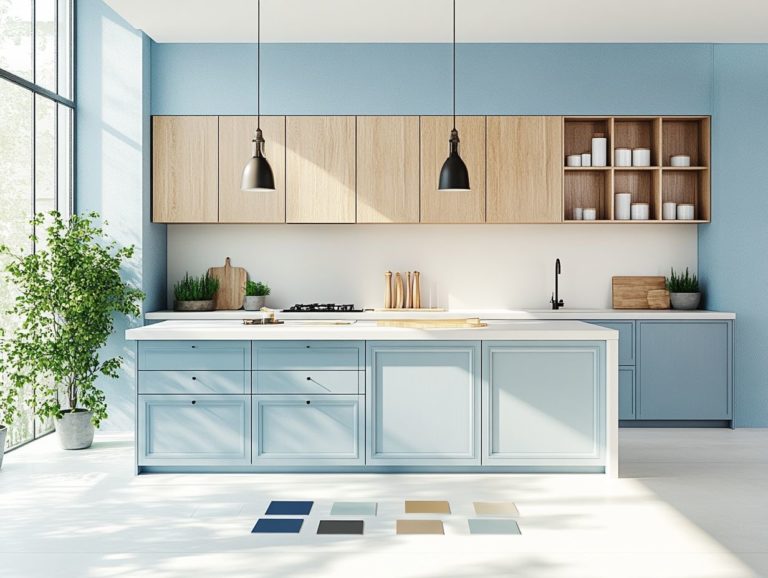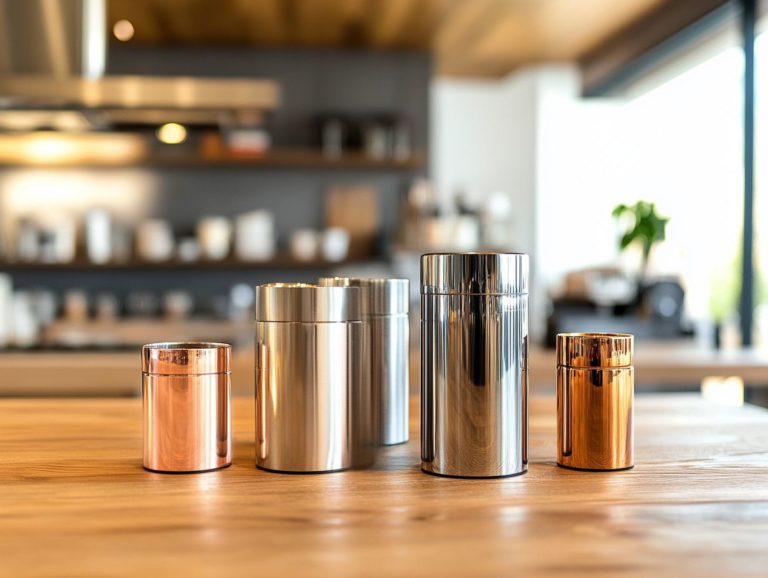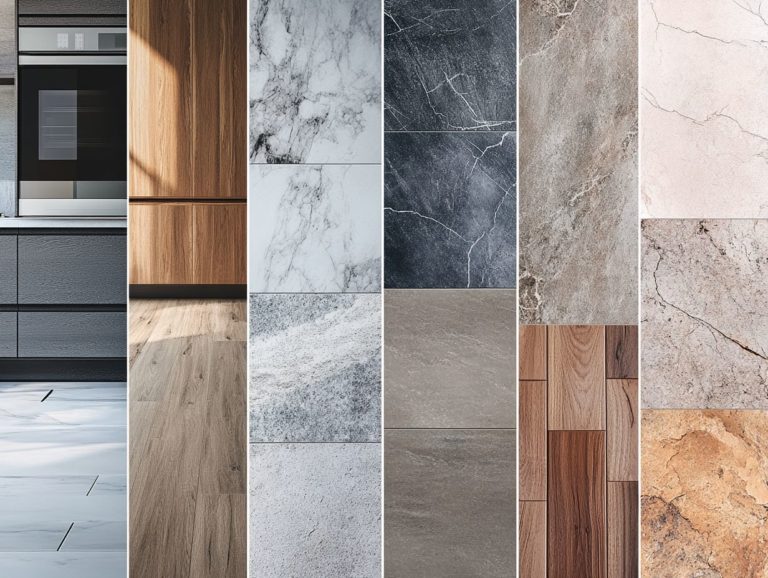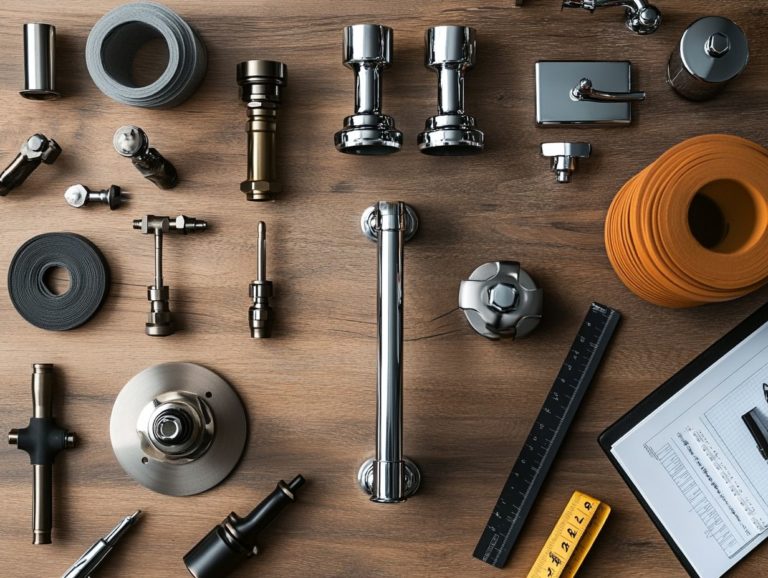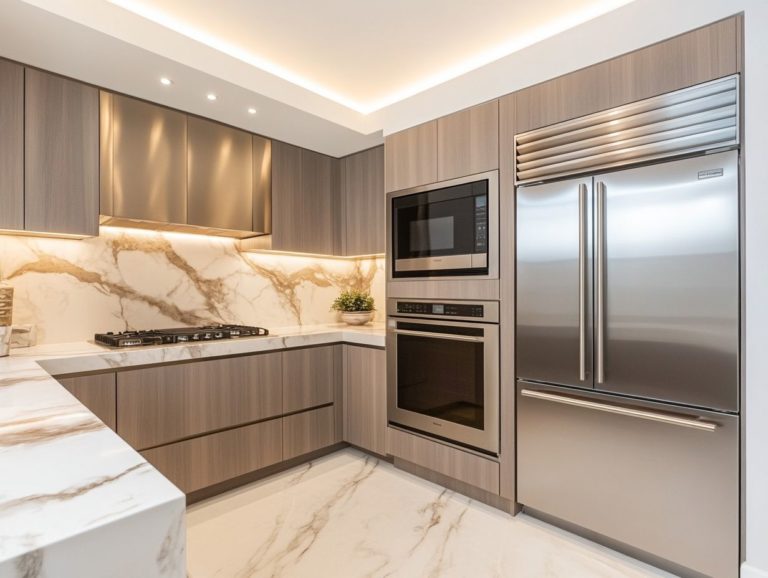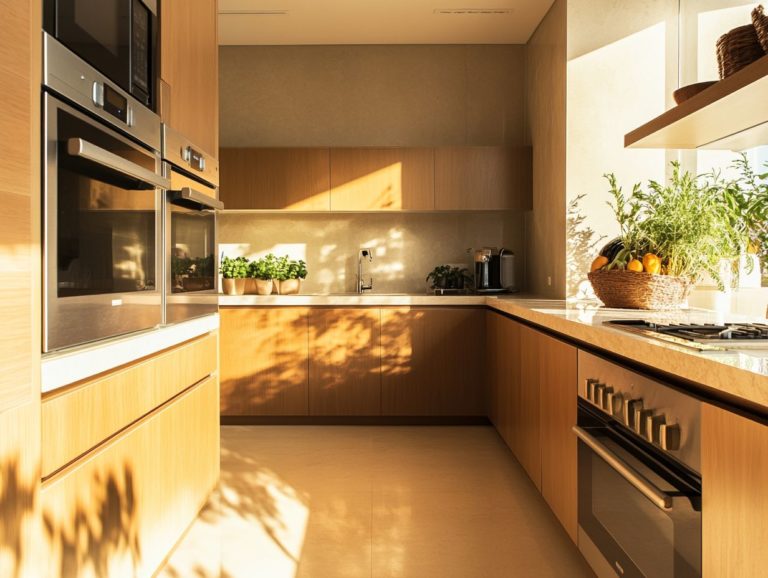Choosing Materials for a Vintage-Inspired Kitchen
Are you envisioning a vintage-style kitchen that radiates charm and character? The right materials can effortlessly transform your space into a nostalgic haven.
This article delves into the art of selecting perfect materials, guiding you through classic wood, retro tiles, and even modern alternatives that are budget-friendly.
Explore tips for mixing and matching elements, incorporating vintage pieces, and discovering DIY ideas to achieve that timeless aesthetic.
You’ll also find essential care tips to ensure your vintage materials remain in pristine condition.
Start your journey to the kitchen of your dreams today!
Contents
- Key Takeaways:
- Defining the Style
- Choosing the Right Materials
- Creating a Cohesive Look
- Budget-Friendly Options
- Maintaining Vintage Materials
- Frequently Asked Questions
- What are some key materials to consider when choosing a vintage-inspired kitchen?
- What types of wood are commonly used in vintage-inspired kitchens?
- Are there any eco-friendly materials that work well in a vintage-inspired kitchen?
- What are some vintage metal finishes that can be incorporated into a kitchen?
- How can I incorporate vintage-inspired materials into a modern kitchen?
- What are some tips for finding and sourcing vintage materials for a kitchen?
Key Takeaways:
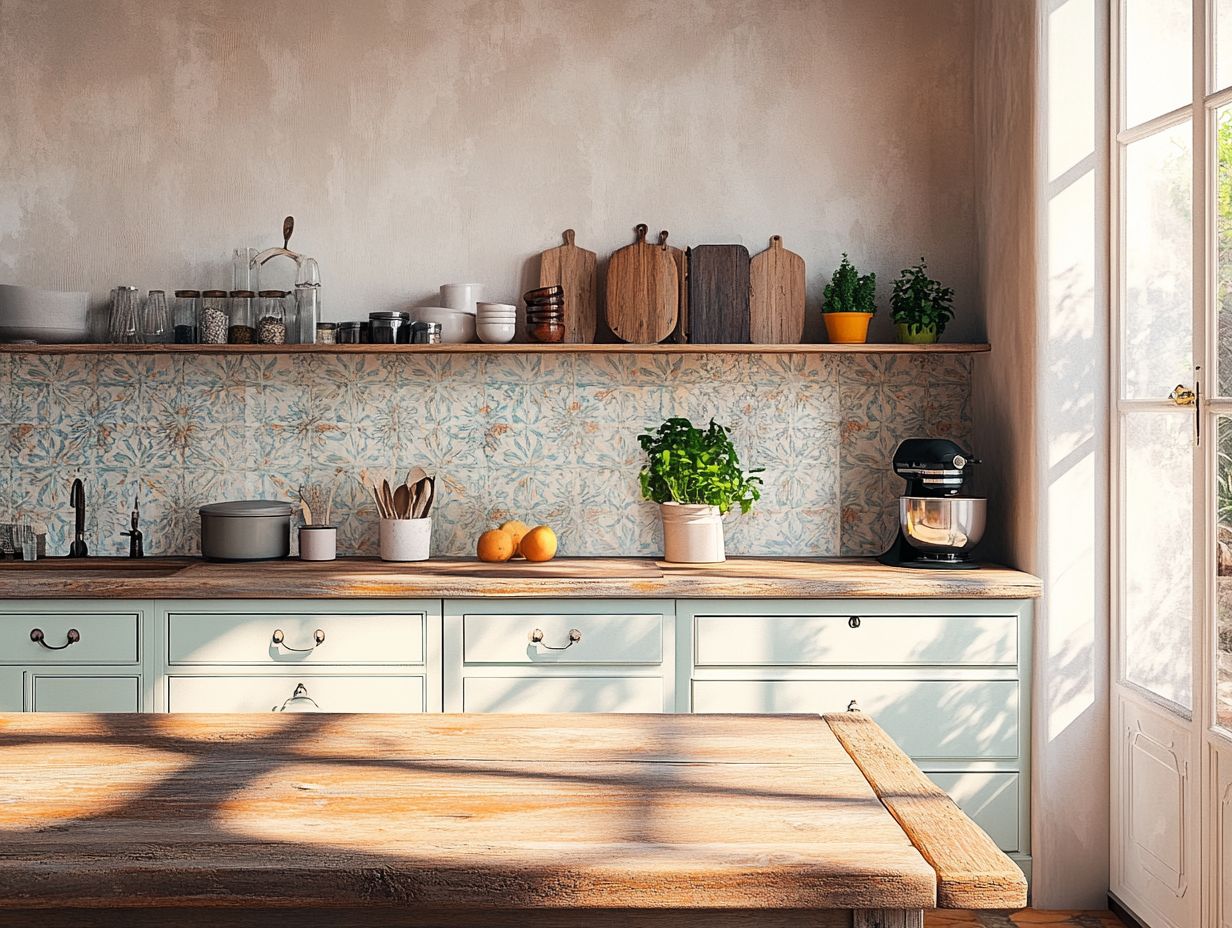
Choose materials that are commonly used in vintage kitchens, such as wood, ceramic, and metal, to achieve an authentic vintage look.
Consider factors like durability, maintenance, and budget when selecting materials for your vintage-style kitchen.
Get creative and mix and match different materials to create a cohesive and unique vintage aesthetic, and incorporate vintage pieces for added character.
Let your creativity shine!
Defining the Style
Defining the style of your kitchen is an essential first step in crafting a vintage-style space that harmoniously blends aesthetics with practicality.
Start by understanding how design reflects history. This understanding helps you echo the historical contexts of various periods, such as the Victorian era, Art Deco, and mid-century modern design.
Focus on design consistency to blend elements that reflect the vintage theme while ensuring that functionality remains a cornerstone of your kitchen’s design.
Choosing the Right Materials
Selecting the right materials is crucial for crafting that perfect vintage-style kitchen, as each element significantly influences both aesthetics and functionality.
From cabinet knobs to farmhouse sinks, every choice should harmonize with your overall design vision, preserving that sought-after vintage charm.
Recognizing the importance of material selection allows you to choose not only beautiful looks but also durable components that stand the test of time.
Common Materials Used in Vintage Kitchens
In vintage kitchens, you’ll often find common materials like reclaimed wood, vintage cabinet hardware, ceramic knobs, and glass knobs, all working together to create that enchanting allure of vintage decor. These materials have a magical way of evoking memories of a bygone era while still providing the modern functionalities that today’s kitchens need.
Reclaimed wood adds a rustic texture and warmth, showcasing rich patinas— the shine or color that develops on surfaces over time—and unique grain patterns that truly enhance the authenticity of vintage aesthetics. Its durability makes it a perfect choice for countertops, cabinetry, and open shelving, creating a welcoming contrast against sleek, contemporary appliances.
Vintage cabinet hardware, like ornate brass knobs and drawer pulls, can act as stunning focal points, effortlessly fitting into both classic and modern designs. Meanwhile, ceramic and glass knobs bring their own charm and character to the mix; their glossy finishes elevate cabinetry and complement polished quartz or marble countertops beautifully.
Together, these materials not only evoke a nostalgic vibe but also ensure practicality, allowing for a seamless blend of old-world elegance and contemporary convenience.
Factors to Consider When Choosing Materials
When selecting materials for a vintage kitchen, a few key factors come into play, such as style, functionality, and finding that perfect balance between aesthetics and practicality. It’s essential to grasp the historical context of the materials—think about the charming finish patina of antique pieces—to ensure every element aligns beautifully with your overall design theme.
Durability is another critical factor that will guide your choices. Vintage kitchens often feature materials like reclaimed wood or cast iron, which not only bring unique character but also withstand the test of time when cared for properly. Regular upkeep can preserve the allure of these elements, enhancing their historical significance even further.
As you consider how well these materials harmonize with modern appliances, you’ll ensure that your kitchen remains fully functional without sacrificing its nostalgic charm. Ultimately, taking a thoughtful approach to material selection allows your kitchen to serve as both a practical cooking space and a stunning tribute to a cherished past.
Ready to create your vintage kitchen? Let’s get started!
Creating a Cohesive Look
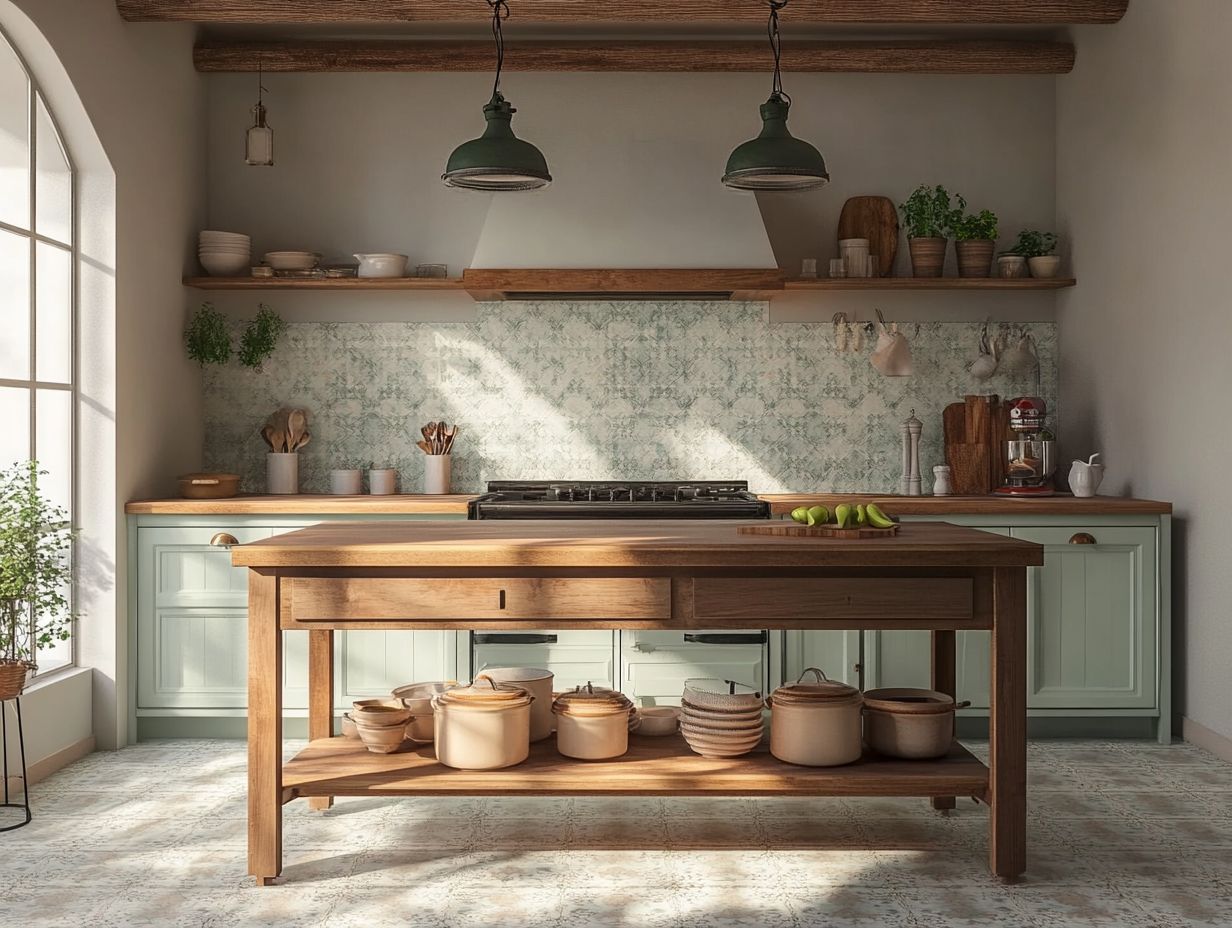
Crafting a cohesive look in your vintage kitchen is essential for achieving design consistency. Every element harmonizes to evoke that timeless vintage charm.
This process entails thoughtfully selecting coordinating elements that represent the eclectic vintage style. Each part should fit together nicely, working together to create an inviting and nostalgic atmosphere.
Mixing and Matching Materials
Mixing and matching materials is an art form that can elevate the vintage charm of your kitchen. You can seamlessly blend modern finishes with traditional elements. This approach adds depth and character to your space while creating a unique and inviting style.
By thoughtfully curating combinations—like pairing reclaimed wood with sleek stainless steel or introducing intricately patterned ceramic tiles alongside minimalist fixtures—you can create a harmonious atmosphere. Exploring contrasts allows for expressive creativity within a carefully maintained look.
It’s essential to ensure that colors and textures complement each other subtly. Consider incorporating a muted palette or selecting statement pieces that resonate with your overall theme. This balance fosters an environment that feels curated yet comfortable, providing space for personal touches amidst timeless elegance.
Incorporating Vintage Pieces
Incorporating vintage pieces into your kitchen design does more than just add personality. It weaves in stories from the past, transforming your kitchen into a unique space. Antique items can act as stunning focal points or subtle accents, blending seamlessly with modern elements.
To effectively integrate vintage decor, explore local flea markets and estate sales. You might also find treasures through online auctions. These sourced items enhance the aesthetics and serve practical purposes—think repurposed cabinets providing both storage and display opportunities.
Elements like retro dishware or a charming farmhouse table draw the eye and infuse warmth into your kitchen. By thoughtfully selecting pieces that resonate with you, your kitchen can evolve into a functional yet enchanting space that tells a cherished story, beautifully merging practicality with history.
Budget-Friendly Options
Exploring budget-friendly options for your vintage kitchen can unlock a world of creativity. You can achieve that timeless charm without straining your wallet.
By considering alternatives to costly materials and embracing DIY ideas, you can craft a kitchen that showcases your unique style while remaining comfortably within your budget.
Alternatives to Expensive Materials
When seeking budget-friendly options, consider alternatives to pricey materials like vintage cabinet hardware and reclaimed wood. These choices preserve the farmhouse aesthetic without stretching your wallet.
By embracing these alternatives, you can create a vintage kitchen that balances style and functionality. For instance, think about using laminate that mimics high-end hardwood or granite countertops. This approach keeps costs down while providing durability and easy maintenance.
Another excellent option is ceramic tiles that emulate the authentic look of distressed wood or stone, offering both budget-friendliness and versatility.
To find these economical materials, local home improvement stores or online marketplaces like Etsy and Wayfair can be invaluable resources. Additionally, exploring salvage yards might reveal unique treasures that won’t break the bank, allowing you to inject a personalized flair into your kitchen design.
Don’t miss out on these incredible finds! Start your vintage kitchen journey today!
DIY Ideas for a Vintage Look
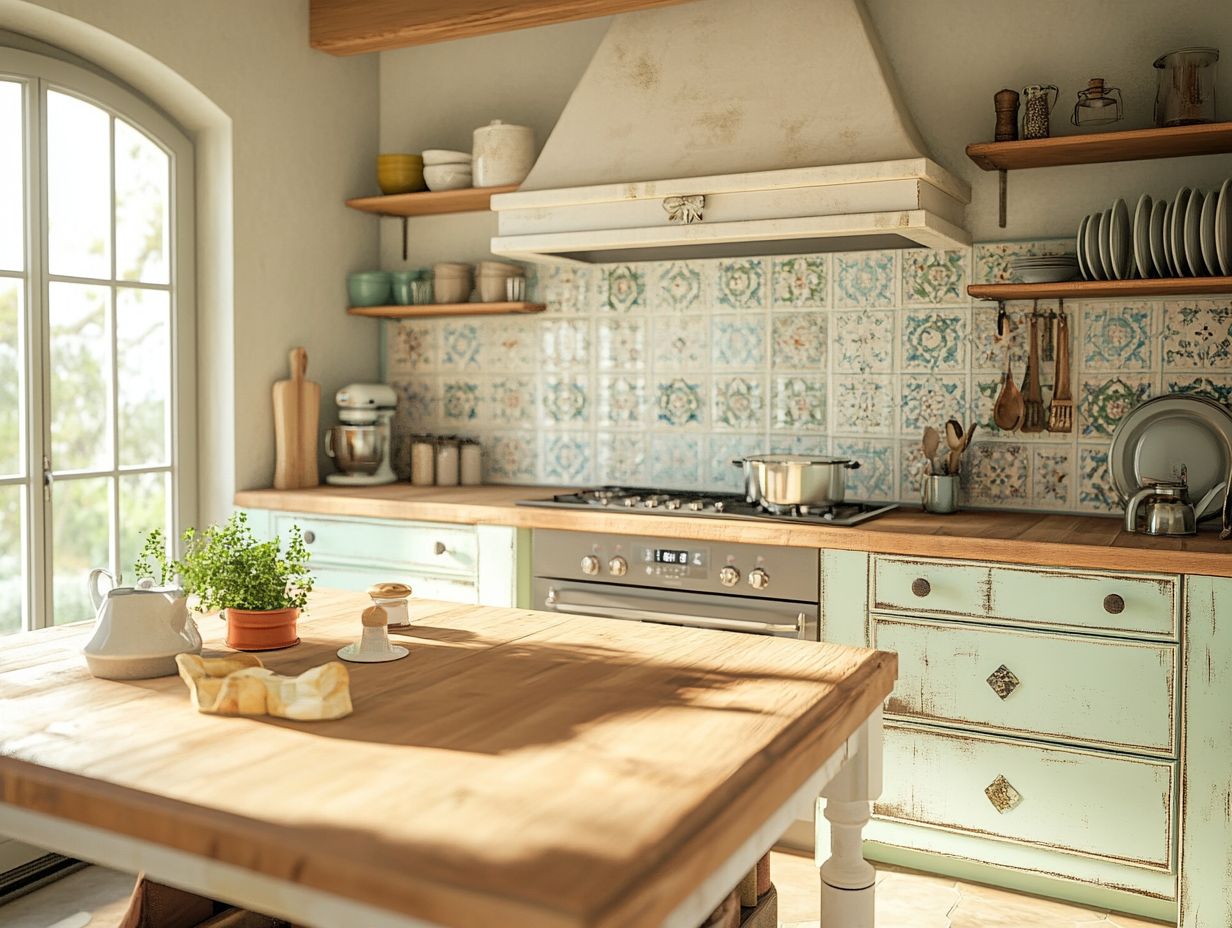
DIY ideas for achieving a vintage look can be delightful and fulfilling. They allow you to infuse your unique personality into the kitchen while enhancing its charm.
From repurposing antique treasures to crafting one-of-a-kind decor elements, you have endless options for creating an inviting vintage haven. You can easily create a nostalgic atmosphere by incorporating rustic touches like distressed wood shelves or charmingly mismatched dishware.
One project that deserves your attention is refurbishing an old wooden cabinet. Start by sanding it down, applying a vintage-inspired paint, and swapping out the hardware for classic knobs that lend an authentic touch.
Another enchanting endeavor involves crafting a fabric bunting from vintage table linens. This not only adds a splash of color but also tells a story of times long past.
With a dash of creativity, these DIY projects can transform your kitchen into a beautiful tribute to the past.
Maintaining Vintage Materials
Maintaining vintage materials in your kitchen is crucial for preserving their beauty and longevity. Cleaning and care tips are invaluable for you as a homeowner.
With the right techniques, you can ensure that your vintage decor and antique pieces retain their exquisite finish, patina, and charm for many years to come.
Cleaning and Care Tips
You need to pay special attention when cleaning and caring for vintage materials to ensure their longevity and aesthetic appeal. Understanding the proper techniques for each material is essential for maintaining their beauty while avoiding damage.
For instance, dust wood surfaces gently with soft cloths, avoiding harsh chemicals that could strip away the natural sheen. When handling metals like brass or bronze, a simple mixture of vinegar and olive oil works wonders, but remember to apply it sparingly.
Leather goods require a different touch. Conditioning them with suitable creams will help restore their suppleness without compromising their structural integrity.
By adopting practices that honor the unique characteristics of these materials, you can preserve the charm and history embedded in each vintage piece. This ensures that your treasured decor remains a source of enjoyment for many years to come.
Frequently Asked Questions
-
What are some key materials to consider when choosing a vintage-inspired kitchen?
Some key materials to consider include reclaimed wood, natural stone, hand-painted tiles, and vintage metal finishes.
-
What types of wood are commonly used in vintage-inspired kitchens?
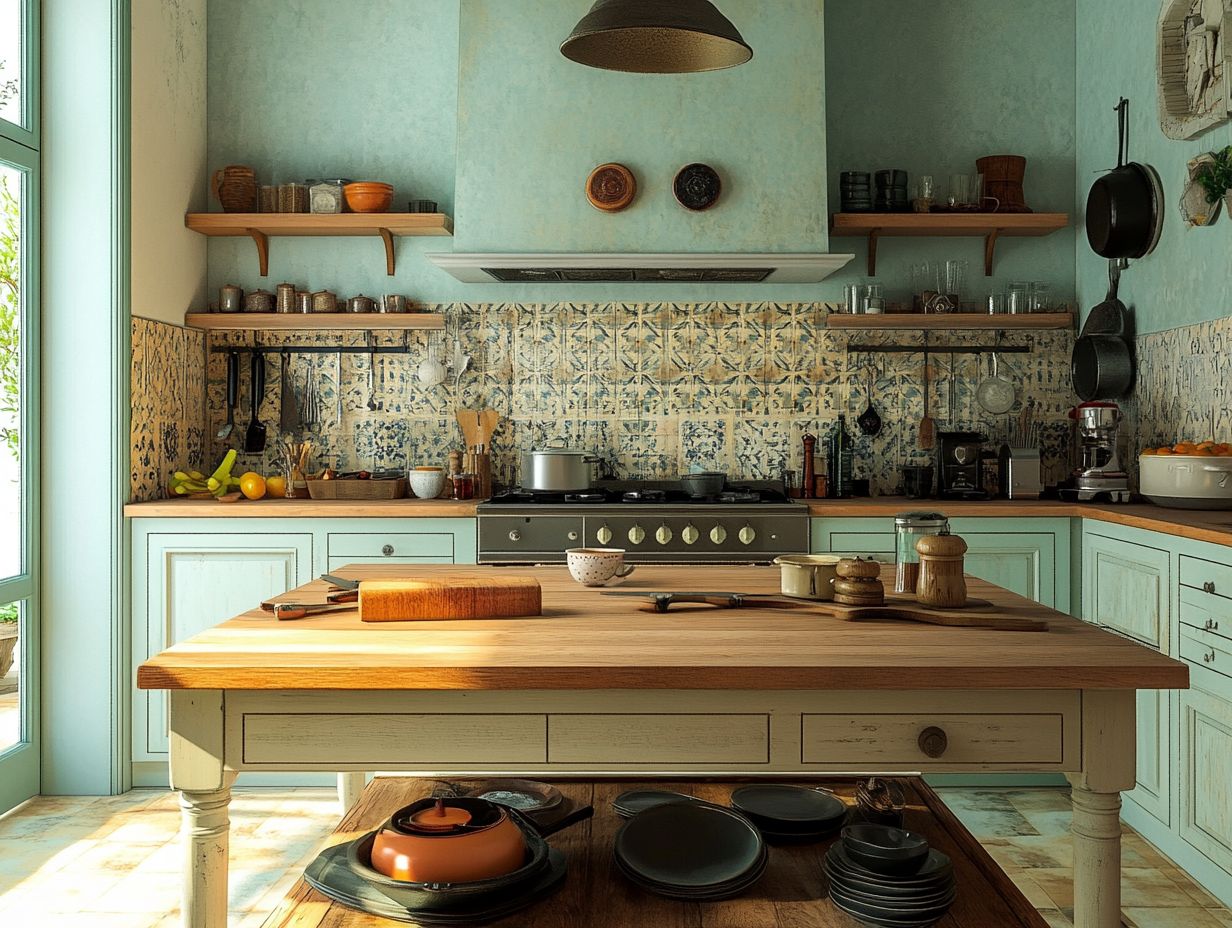
Common types of wood used in vintage-inspired kitchens include oak, pine, and cherry, as these woods were popular during the time period most vintage kitchens are inspired by.
-
Are there any eco-friendly materials that work well in a vintage-inspired kitchen?
Yes, there are several eco-friendly materials that can be used, such as bamboo or recycled glass for countertops, and reclaimed or sustainably-sourced wood for cabinets and flooring.
-
What are some vintage metal finishes that can be incorporated into a kitchen?
Vintage metal finishes like brushed brass, aged copper, and antique bronze can add authenticity and nostalgia to a vintage-inspired kitchen.
-
How can I incorporate vintage-inspired materials into a modern kitchen?
Incorporating vintage-inspired materials can be achieved by mixing modern and vintage elements. Pair vintage metal finishes with sleek appliances or use vintage-inspired tiles as a backsplash in an otherwise modern kitchen.
-
What are some tips for finding and sourcing vintage materials for a kitchen?
Some tips include checking out local antique shops, salvage yards, and online marketplaces. Consider reusing or repurposing materials from other vintage homes or buildings.
